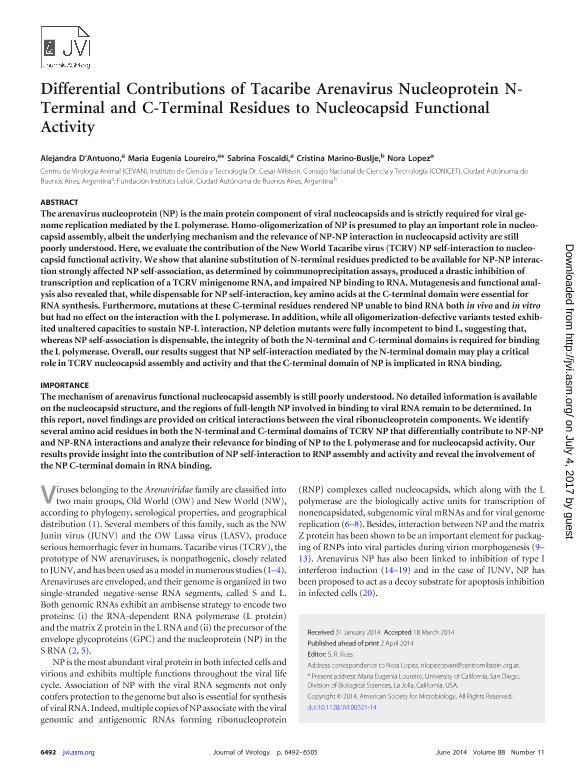Artículo
Differential contribution of Tacaribe arenavirus Nucleoprotein N-terminal and C-terminal residues to nucleocapsid functional activity
D'antuono, Alejandra Lorena ; Loureiro, Maria Eugenia
; Loureiro, Maria Eugenia ; Foscaldi, Sabrina Andrea
; Foscaldi, Sabrina Andrea ; Marino, Cristina Ester
; Marino, Cristina Ester ; Lopez, Nora Mabel
; Lopez, Nora Mabel
 ; Loureiro, Maria Eugenia
; Loureiro, Maria Eugenia ; Foscaldi, Sabrina Andrea
; Foscaldi, Sabrina Andrea ; Marino, Cristina Ester
; Marino, Cristina Ester ; Lopez, Nora Mabel
; Lopez, Nora Mabel
Fecha de publicación:
06/2014
Editorial:
American Society For Microbiology
Revista:
Journal Of Virology
ISSN:
0022-538X
e-ISSN:
1098-5514
Idioma:
Inglés
Tipo de recurso:
Artículo publicado
Clasificación temática:
Resumen
The arenavirus nucleoprotein (NP) is the main protein component of viral nucleocapsids and is strictly required for viral genome replication mediated by the L polymerase. Homo-oligomerization of NP is presumed to play an important role in nucleocapsid assembly, albeit the underlying mechanism and the relevance of NP-NP interaction in nucleocapsid activity are still poorly understood. Here, we evaluate the contribution of the New World Tacaribe virus (TCRV) NP self-interaction to nucleocapsid functional activity. We show that alanine substitution of N-terminal residues predicted to be available for NP-NP interaction strongly affected NP self-association, as determined by coimmunoprecipitation assays, produced a drastic inhibition of transcription and replication of a TCRV minigenome RNA, and impaired NP binding to RNA. Mutagenesis and functional analysis also revealed that, while dispensable for NP self-interaction, key amino acids at the C-terminal domain were essential for RNA synthesis. Furthermore, mutations at these C-terminal residues rendered NP unable to bind RNA both in vivo and in vitro but had no effect on the interaction with the L polymerase. In addition, while all oligomerization-defective variants tested exhibited unaltered capacities to sustain NP-L interaction, NP deletion mutants were fully incompetent to bind L, suggesting that, whereas NP self-association is dispensable, the integrity of both the N-terminal and C-terminal domains is required for binding the L polymerase. Overall, our results suggest that NP self-interaction mediated by the N-terminal domain may play a critical role in TCRV nucleocapsid assembly and activity and that the C-terminal domain of NP is implicated in RNA binding. IMPORTANCE: The mechanism of arenavirus functional nucleocapsid assembly is still poorly understood. No detailed information is available on the nucleocapsid structure, and the regions of full-length NP involved in binding to viral RNA remain to be determined. In this report, novel findings are provided on critical interactions between the viral ribonucleoprotein components. We identify several amino acid residues in both the N-terminal and C-terminal domains of TCRV NP that differentially contribute to NP-NP and NP-RNA interactions and analyze their relevance for binding of NP to the L polymerase and for nucleocapsid activity. Our results provide insight into the contribution of NP self-interaction to RNP assembly and activity and reveal the involvement of the NP C-terminal domain in RNA binding.
Palabras clave:
Tcrv
,
Nucleoprotein
Archivos asociados
Licencia
Identificadores
Colecciones
Articulos(ICT - MILSTEIN)
Articulos de INST.DE CS. Y TECNOLOGIA "DR. CESAR MILSTEIN"
Articulos de INST.DE CS. Y TECNOLOGIA "DR. CESAR MILSTEIN"
Articulos(IIBBA)
Articulos de INST.DE INVEST.BIOQUIMICAS DE BS.AS(I)
Articulos de INST.DE INVEST.BIOQUIMICAS DE BS.AS(I)
Citación
D'antuono, Alejandra Lorena; Loureiro, Maria Eugenia; Foscaldi, Sabrina Andrea; Marino, Cristina Ester; Lopez, Nora Mabel; Differential contribution of Tacaribe arenavirus Nucleoprotein N-terminal and C-terminal residues to nucleocapsid functional activity; American Society For Microbiology; Journal Of Virology; 88; 11; 6-2014; 6492-6505
Compartir
Altmétricas



